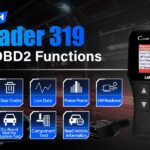Every modern vehicle, including the 2019 Jeep Cherokee, is equipped with an On-Board Diagnostics (OBD2) port. This port is essential for accessing your vehicle’s computer system for diagnostics and maintenance. For mechanics and car owners alike, locating this port is the first step in using diagnostic tools. While standardized, the exact location can sometimes be tricky to find. This article will guide you directly to the OBD2 port location in your 2019 Jeep Cherokee, ensuring you can quickly connect your diagnostic scanner and get the information you need.
Understanding the OBD2 port is crucial for anyone wanting to monitor their vehicle’s health or perform repairs. Since the OBD-II standard was implemented in the mid-1990s, a standardized 16-pin connector became mandatory for all cars sold in the United States and many other parts of the world. This standardization simplifies vehicle diagnostics, allowing you to use a wide range of OBD2 scanners and software. The OBD2 system monitors various aspects of your vehicle’s performance, from engine and transmission to emissions and more. By connecting a scanner to the OBD2 port, you can read diagnostic trouble codes (DTCs), access live data, and perform various tests to pinpoint issues or ensure your vehicle is running optimally.
Spotting the OBD2 Port in a 2019 Jeep Cherokee
For the 2019 Jeep Cherokee, the OBD2 port is typically located inside the passenger compartment. You won’t need to search under the hood or in the trunk. Specifically, you should look for the OBD2 port beneath the steering column. It’s usually situated on the driver’s side, within easy reach once you’re seated. You may need to crouch down slightly and look under the dashboard area, just below the steering wheel.
In most cases, the port is not hidden behind a panel, but it might be in a slightly recessed area. It resembles a trapezoid shape with 16 pins inside. Once you know where to look, you’ll find that it’s quite accessible for plugging in your OBD2 scanner. Knowing the precise location saves you valuable time, especially when you need to quickly diagnose a warning light or check your vehicle’s status.
Utilizing Your 2019 Jeep Cherokee OBD2 Port
Once you’ve located the OBD2 port in your 2019 Jeep Cherokee, you can connect a compatible OBD2 scanner. These scanners range from basic code readers to more advanced professional-grade tools. By connecting a scanner, you can:
- Read Diagnostic Trouble Codes (DTCs): Understand why your check engine light or other warning lights are illuminated.
- Clear DTCs: Reset the check engine light after addressing the underlying issue.
- View Live Data: Monitor real-time parameters from your engine and other systems, such as engine speed, coolant temperature, and oxygen sensor readings.
- Perform Emissions Tests: Check your vehicle’s readiness for emissions testing.
- Access Vehicle Information: Retrieve your vehicle’s VIN and other identification data.
To get started with diagnosing your 2019 Jeep Cherokee, you’ll need an OBD2 scanner and potentially diagnostic software. There are many options available, from handheld scanners to smartphone-based solutions. Ensure the scanner you choose is compatible with OBD2 protocols and ideally supports the features you need for your diagnostic tasks.
If you’re looking for software to enhance your diagnostic capabilities, consider exploring options like EOBD-Facile car diagnostic software. This type of software, when paired with a compatible OBD2 scanner, can provide in-depth insights into your vehicle’s health.
Conclusion
Locating the OBD2 port in your 2019 Jeep Cherokee is a straightforward process once you know where to look. Remember, it’s typically positioned under the steering column on the driver’s side. This accessibility allows for quick and easy connection of OBD2 scanners, empowering you to perform essential vehicle diagnostics and maintenance. By utilizing the OBD2 port, you can stay informed about your 2019 Jeep Cherokee’s condition, address potential issues promptly, and ensure its continued reliable performance.
If you’re interested in finding the OBD2 port location for other vehicles or need further diagnostic assistance, resources and communities are available to help you. Always ensure you are using reliable tools and software for accurate vehicle diagnostics.
